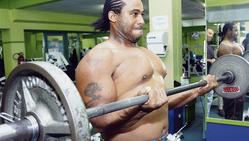
Kenneth Gardner
In our continuing series of articles on improving your workout routine, we now include a basic workout programme for you to follow. The full accumulation of exercises, sets and reps, performed during a workout is called a programme or training schedule.
As you perform several sets of exercises for a particular muscle group, your muscles become congested with blood which is forced into the area to remove carbon dioxide and other fatigue byproducts and replace them with oxygen and glycogen. All these exercises, when done correctly, will dramatically improve the muscular strength and function of specific body parts.
The leg raise exercise, for example, will work the abdominal muscles, and the dumb-bell shoulder shrug will help to develop the shoulders. It's up to you to decide which exercises best suits your aim and start working toward your goals. If developing lower body strength is your aim, then concentrate on exercises that will work the calf, hamstring and quadriceps group.
Lift manageable weights
Here is another list of exercises along with a programme that you can use. It is recommended that you use a programme when working out as this will help tomonitor your progress. Remember to try and work out on every other day to give the muscles enough time to recover and only lift weights that you can manage. Also, ensure that you get enough rest between each set completed and increase your load gradually as you start to adapt. Results will gradually become obvious as soon as you start increasing how much weight you can lift.

Efficient leg raises demonstrated by Damion Christian.
1) Leg raises
Lie on your back on an inclined abdominal board with your head toward the upper end.
Grasp foot restraint to stabilise body during motion.
Raise feet in a semicircular arc to a position above hips.
Return feet to normal position.
2) Dumb-bell shoulder shrugs
Grasp two dumb-bells at side with feet shoulder width apart.
Raise shoulders as high as possible toward head.
Lower dumb-bells back to starting position and repeat.
3) Standing dumb-bell curls
Grasp two dumb-bells at side with feet shoulder width apart.
Curl dumb-bell forward and upwards toward the shoulders.
Lower dumb-bells slowly back to starting position and repeat.
4) Jumping squat
Place a barbell across shoulders behind neck and hold firmly.
Set feet shoulder width apart.
Slowly move into a squatting position.
Quickly accelerate the movement by springing off the floor.
Bend legs to help absorb shock of landing.
5) Universal bench press
Lie flat on back, reach up to take an over-grip of the handles.
Straighten your arms to raise the pressing handles directly above your shoulder.
Slowly bend your arms and lower weight back to resting position and repeat.
6) Barbell reverse curls
Over-grip bar shoulder width apart, with feet comfortable and bar resting across your upper thigh.
Curl barbell upwards toward chin
Lower weight back along same arc to starting position.
7) Angled leg press
Lie with back against the angled back pad with feet shoulder widthapart and on foot plate.
Straighten your legs and release weight lever.
Slowly bend your legs as completely as possible while lowering weight.
Press weight out until your legs are straight.
8) Barbell upright rows
Take a narrow over-grip in the middle of a barbell handle.
Place feet shoulder width apart with barbell resting across your upper thighs.
Slowly pull the barbell upwards until the back of your fists are touching the underside of your chin.
Lower weight to starting position and repeat.

Kenneth Gardner is an exercise physiologist at the G. C. Foster College of Physical Education: email: yourhealth@gleanerjm.com.

